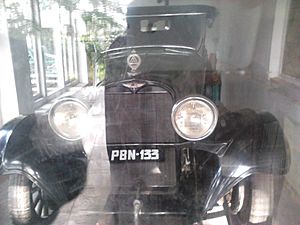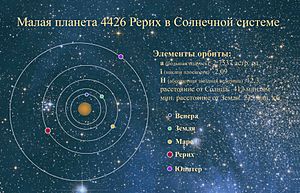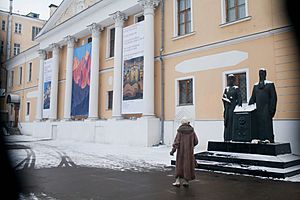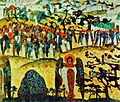Nicholas Roerich facts for kids
Quick facts for kids
Nicholas Roerich
|
|
|---|---|
| Николай Рерих | |

Roerich c. 1940–1947
|
|
| Born | October 9, 1874 |
| Died | December 13, 1947 (aged 73) Naggar, Dominion of India
|
| Nationality | Russian |
| Occupation | painter, archaeologist, costume and set designer for ballets, operas, and dramas |
| Spouse(s) | Helena Roerich |
| Children | George de Roerich, Svetoslav Roerich |
| Signature | |
 |
|
Nicholas Roerich (born October 9, 1874 – died December 13, 1947) was a famous Russian artist. He was also a writer, archaeologist, and a thinker. Roerich was known for his paintings, especially those showing ancient Russia.
He traveled a lot during his life, finally settling in Naggar, India. Nicholas Roerich was trained as both an artist and a lawyer. His main interests were art, history, and understanding the world.
Roerich worked hard to protect art and old buildings, especially during wars. He was even suggested for the Nobel Peace Prize many times. In 1935, a special agreement called the Roerich Pact was signed. This pact helps protect important cultural places and objects during conflicts.
Contents
Early Life and Artistic Journey
Nicholas Roerich was born in Saint Petersburg, Russia. His father was from a German family, and his mother was Russian. In 1893, when he was young, he started studying at two places at once. He went to St. Petersburg University and the Imperial Academy of Arts.
He became a certified artist in 1897. The next year, he also earned a law degree. Roerich started working for the Imperial Society for the Encouragement of the Arts. He even became the director of their school from 1906 to 1917.
He also joined a group called "World of Art." This group was led by Sergei Diaghilev. Roerich was the president of this art society from 1910 to 1916.
Painting Ancient Russia
As an artist, Roerich became famous for painting Russia's ancient past. This fit perfectly with his love for archaeology, which is the study of old human history. He was also a talented stage designer.
He became very well-known for his work with Diaghilev's Ballets Russes. His most famous designs were for the opera Prince Igor (1909). He also designed costumes and sets for the ballet The Rite of Spring (1913). This famous ballet had music by Igor Stravinsky.

Roerich is seen as an important artist in Russian Symbolism. This was an art movement that used symbols to express ideas.
Protecting Art and Buildings
Another important part of Roerich's art was architecture. He published a book called "Architectural Studies" (1904–1905). This book had many paintings of old fortresses, monasteries, and churches in Russia. These paintings inspired him to work for decades to protect art and old buildings.
He also designed religious art for churches in Russia and Ukraine. One famous piece is the Queen of Heaven fresco.
After the February Revolution of 1917, the old Russian government ended. Roerich had to leave the capital city. He moved to Karelia, a region near Finland. He had already left his art leadership roles. In early 1918, he and his wife, Helena, and their two sons, George and Svetoslav, moved to Finland.
After some time in Finland and other Nordic countries, the Roerich family moved to London in 1919. In 1924, they moved to New York City in the United States. There, they started several organizations. These included Cor Ardens and Corona Mundi, which aimed to bring artists together. They also founded the Master Institute of United Arts, an art school. This school later became the home of the first Nicholas Roerich Museum.
Later Life and Expeditions
From 1925 to 1935, Roerich and his family went on several trips. They explored areas like Tibet and Manchuria. These trips were for both art and science.
The Roerichs explored parts of Inner Mongolia, including the Gobi Desert. They found nearly 300 types of plants that grow in dry places. They also collected herbs and studied old historical sites. They even found ancient writings that were very important for science.
Death
Nicholas Roerich passed away in Kullu, India, on December 13, 1947.
Legacy and Recognition
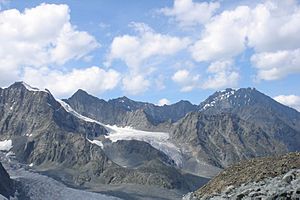
You can see Roerich's paintings in many museums around the world. There are collections in Moscow, Saint Petersburg, and Novosibirsk in Russia. There are also important collections in Sofia, Bulgaria, and in various art museums in India. The Latvian National Museum of Art also has some of his larger works.
Roerich received the Order of St. Sava, a special award. A minor planet in our Solar System is named 4426 Roerich in his honor. Also, a crater on the planet Mercury is named after him.
In 2013, one of Roerich's paintings, Madonna Laboris, was sold at an auction in London. It sold for a very high price, making it one of the most valuable Russian paintings ever sold at auction.
Images for kids
-
Guests from Overseas, depicting Rus' people, 1901
-
Kiss to the Earth, 1912, scenery for Diaghilev’s The Rite of Spring ballet
-
Monhegan, Maine, 1922
-
Kanchenjunga, 1936
See also
 In Spanish: Nikolái Roerich para niños
In Spanish: Nikolái Roerich para niños



